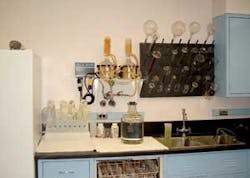BOD:COD Correlation Provides Operations, Laboratory Benefits
Since the introduction of the closed-reflux micro method in the early 1980s, COD analysis has become increasingly used at municipal wastewater treatment plants for process monitoring and to aid in process control. Some facilities have taken this one step further - replacing BOD with COD analysis to meet NPDES reporting requirements following long-term validation testing. The 5.71 mgd Lewiston, Idaho, Wastewater Treatment Plant is today striving to do just that.
Biochemical Oxygen Demand (BOD) analysis is the test everyone loves to hate - and for compelling reasons. The test has a number of disadvantages: a five-day incubation period, extensive sample preparation and, often, difficulties in obtaining consistent repetitive values.
From an operations perspective, time lag is the biggest drawback to BOD (also referred to as Biological Oxygen Demand) analysis. It is too slow to provide timely information to the operator for control purposes. This is because BOD of incoming wastewater can vary significantly over days and hours, and BOD measurement takes five days to complete.
In addition, there is no measure of accuracy with BOD analysis. According to Standard Methods for the Examination of Water and Wastewater (21st edition), “no measurement exists for establishing bias in the BOD procedure under precision and bias.”
The glucose/glumatic acid (G&GA) check, often viewed as a BOD quality control, does not indicate the accuracy of the method, but rather demonstrates that the seed is actually generating the enzymes needed to catalyze the oxidation of any organic material that might be in the sample.
Chemical Oxygen Demand (COD) analysis, on the other hand, is an accurate method that can be validated through a standard (KHP/ potassium hydrogen phthalate). Also, results are available in about two hours. COD analysis has been an easy procedure to perform since the early 1980s, with the introduction of the Hach Closed-Reflux Micro Method that uses pre-dosed reagents.
BOD:COD Correlation
COD typically correlates to BOD, which is one of the reasons the method was initially developed. It has been found to be a very useful tool in municipal wastewater treatment process monitoring and modeling, and to aid in process control.
To measure oxygen demand, the BOD method relies on enzymes produced by bacteria to catalyze the oxidation of organic matter during a five-day incubation period. In contrast, COD methods use chemical oxidants to oxidize organic matter. BOD simulates the actual treatment plant process by measuring the organic material that can be oxidized with the oxygen in the sample when catalyzed by bacterial enzymes. Although COD is comparable to BOD, COD actually measures chemically oxidizable matter.
A ratio can usually be established between the two analytical methods once COD and BOD data has been gathered over time. Many municipal laboratories are also finding that parallel COD and BOD testing is beneficial because the COD test can be used to target a specific BOD range, thereby eliminating the need for multiple BOD dilutions.
For plant operations, the benefits of COD testing are often significant. BOD analysis is performed mainly to satisfy permit requirements. By the time a plant receives the value, the waste stream it characterizes has left the plant and is down the river. With COD analysis, however, early knowledge of the strength of incoming water allows plant operators to optimize treatment processes, because the value measured provides a quantitive estimate of everything currently in the waste stream that can be oxidized.
Because the COD test can be run in a couple of hours instead of five days, it gives the operator a more timely idea of loadings entering the plant and how the plant is performing, thereby permitting closer operational control of the treatment process. Technicians are able to quickly respond to changes in oxygen demand and adjust treatment processes accordingly.
Reporting
Although the BOD:COD correlation allows facilities to use COD analysis to aid in monitoring and operations, most municipal wastewater treatment plants perform BOD testing to meet their NPDES reporting requirements. Over the years, however, some facilities have taken steps to change this by validating the BOD:COD correlation to allow COD to be substituted for BOD analysis. The Lewiston, Idaho, Wastewater Treatment Plant, for example, has recently begun conducting COD validation testing to demonstrate to the Idaho Department of Environmental Quality (DEQ) a long-term correlation of COD and BOD values at the facility. The plant’s goal is to ultimately replace BOD with COD analysis.
Lewiston is located in northwest Idaho, at the confluence of the Snake and Clearwater Rivers. The city’s 5.71 mgd activated sludge wastewater treatment plant treats an average of 3.9 mgd and serves a population of approximately 35,000. Services provided by the plant’s in-house laboratory include the analysis of wastewater influent and effluent for compliance and performance purposes, with parameters including: temperature, BOD, COD, total suspended solids (TSS), fecal coliform, pH, E.coli, as well as periodic tests, such as volatile suspended solids testing to determine percent solids reduction from the facility’s digesters. Monthly tests for parameters such as nutrients are contracted to an outside laboratory.
“Our goal is to eliminate BOD testing altogether,” said Rich Wayt, laboratory technician for the Lewiston facility. At the option of the NPDES permitting authority, effluent guidelines regulations (40 CFR Chapter I Subchapter N: Effluent Guidelines and Standards; and Secondary Treatment Regulations found in R.61-9.133) allow COD to be substituted for BOD when a long-term BOD:COD correlation has been demonstrated.
“This will allow us to eliminate some very time-consuming procedures and make us more efficient,” Wayt said. “BOD analysis requires a lot of man-hours. COD analysis is less extensive to perform than BOD, labor-wise, and COD is more precise and easier to work with analytically.”
Another benefit to eliminating BOD, Wayt said, is that it will maximize bench space in the lab. With BOD analysis, five dilutions are recommended. A typical wastewater treatment plant, such as the Lewiston facility, that measures two sample points will - every day - be running 10 bottles for the dilutions, another four bottles to run G&GA checks (which is highly recommended), at least one bottle as a blank and four for seed. Replacing BOD analysis with COD at the Lewiston facility will eliminate this.
“At this stage, we’re basically testing COD along with our BOD and collecting the data,” Wayt said. “We must run our CODs with our BODs every day - and we can’t miss a single COD test. After one year, a long-term comparison of the data will be made. To date, we’ve been staying fairly close to within a 2:1 ratio between BOD and COD, which is the range required by the DEQ.”
Using Prepared COD Reagents
Before it began its long-term validation study, the Lewiston plant had never conducted COD analysis before.
For testing, the Lewiston lab uses the closed-reflux micro method using Hach COD digestion vials. The pre-dosed reagents are contained in 16mm glass tubes, or vials, that fit directly into all commercially available COD reactors and spectrophotometers. The prepared COD reagents minimize handling of corrosive and toxic chemicals, and eliminate pipetting and measuring hazardous reagents. The Lewiston facility is participating in Hach’s SIRR (scheduled inventory reagent replacement) plan, a program designed to lower inventory costs and reduce time-consuming paperwork at the plant relative to its reagent use.
Wayt said COD testing is a very straightforward procedure.
“The pre-dosed COD reagents are accurate and very simple to use. We use 3-to-150 mg/L COD digestion vials for our effluent tests and 20-to-1500 mg/L vials for our influent tests. After 3 mils of sample are added to a vial, the vial is capped and placed in the reactor to digest at 150°C for two hours,” he said. “After the vial is cooled, results are then read directly on our spectrophotometer.”
The plant uses a Hach DR/2500 Spectrophotometer, which provides lab personnel the ability to save COD and other frequently used programs for quick access.
“Our whole COD testing procedure is fairly undemanding and, so far, trouble-free,” Wayt said. “And it’s a whole lot easier than carrying out a BOD test.”
Conclusion
Once COD and BOD data has been gathered over time, the average BOD result is divided by the average COD result to determine the ratio, or conversion factor. The COD results are multiplied by this factor to estimate BOD concentration. COD values are almost always higher than BOD results for the same sample, therefore the conversion factor is most always less than one.
“The best thing about COD analysis for us is that we get our results today - in just a couple of hours. Whereas with BOD testing, we have to wait five days,” Wayt said. “With our validation program, if we can eliminate BOD testing altogether and only run COD, it will make our lab, and our plant operations, much more efficient.”
In the event the COD validation program demonstrates that BOD analysis must still play a required role in the plant’s testing program, Wayt said the Lewiston facility will likely continue performing COD analysis for the reasons many municipal plants run the test even though it’s typically not required - to provide effective process monitoring and aid in process control, and to eliminate the need for multiple BOD dilutions.
About the author:
Chris Fair is R&D Chem II for Hach, Inc., Loveland, CC. He graduated with a B.S. in Chemistry from the University of West Florida in 1994. From 1992 until 1994 he worked for the Environmental Laboratory at PWC, NAS Pensacola. Afterward he pursued laboratory analysis and various method development projects. Three years ago, he was employed by Hach Company as an R&D chemist assigned to the wastewater field where he is currently investigating possibilities for simplification and improvement in oxygen demand testing.




